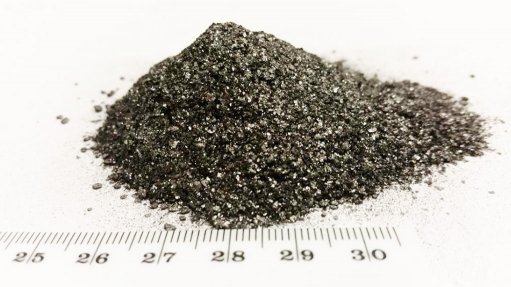
GRAPHITE SAMPLE About a third of the graphite in Triton Minerals’s deposit is jumbo flake and about 59% is large flake
The external support for the Ancuabe graphite project, in the Cabo Delgado province, in Mozambique, in the form of a second binding offtake agreement signed last month, provides “strong” momentum for the engineering, procurement and construction (EPC), financing and development objectives of the project, says graphite developer Triton Minerals.
Triton Minerals MD Peter Canterbury highlights that the EPC, financing and development objectives are on track to enable an investment decision this year and first production from Ancuabe in late 2019.
In May, Triton signed a second binding offtake agreement for Ancuabe with Chinese major graphite company Qingdao Chenyang Graphite. The agreement covers up to 16 000 t/y of graphite concentrate for at least five years, with a seller option for a further five years. The minimum quantity under the offtake agreement is for 10 000 t/y across a range of graphite product specifications.
Chenyang, one of the largest graphite companies in the Qingdao area of Shandong province, is focused on graphite processing and trading, and producing advanced graphite products for customers in China, Japan and Korea.
“Securing binding agreements for up to 50% of foremost annual production with experienced graphite producers in Chenyang and Tianshengda, China demonstrates the success of Triton’s product marketing strategy and the demand for large flake, high purity graphite in the Chinese market,” adds Canterbury.
The selling price under the offtake agreement will be determined by the prevailing market prices in China, and will be subject to range, ensuring that Triton retains exposure to anticipated strong demand and projected prices for ‘premium-quality’ graphite. The project is expected to produce its first graphite in the second half of 2019, subject to financing and board approvals.
Triton, however, continues to receive strong expressions of interest for offtake and continues to progress negotiations with other offtake parties.
Prospects
Ancuabe has a maiden Joint Ore Reserves Committee-compliant ore reserve of 24.9-million tonnes at 6.2% total graphitic carbon based on the T12 and T16 mineral deposits.
The definitive feasibility study (DFS) on the deposits carried out by the company confirmed the high quality, long life and high margin of the project.
The DFS is based on production of about 60 000 t/y of graphite concentrate over 27 years. The mine plan is based on the ore reserve, and less than 5% of production is sourced from inferred mineral resources, which is mined to access the ore reserve, Creamer Media’s Research Channel Africa reported last month.
Triton Minerals has planned a conventional drill-and-blast, load-and-haul, openpit mine or mining plan which will be used to extract the mineralised material. Further, run-of-mine (RoM) feed will be defined by grade-control procedures in the pit, and delivered by truck to the RoM pad located centrally between the T12 and T16 deposits. The company has planned that mining activities will be carried out by an experienced earthmoving contractor.
Additionally, Ancuabe’s process plant will have a throughput of between 900 000 t/y to 1.1-million tonnes a year to produce an estimated 60 000 t/y graphite concentrate.
Proposed process plant facilities include a RoM pad, a tertiary crushing circuit, a rod mill feed bin and grinding circuit, rougher flotation, three stages of attritioning and five stages of cleaner flotation, concentrate filtration, concentrate drying, classification and bagging of three products, tailings thickening and storage, and reagents.
About a third of the graphite in Triton’s deposit is jumbo flake and about 59% is large flake, which attracts higher prices over smaller flake graphite.
The project has an unleveraged pretax net present value, at a 10% discount rate, of $298-million and an internal rate of return of 36.8%, with a near-term payback of 3.8 years.
While Ancuabe remains Triton Minerals’ key focus, the company, through its majority 80% interest in holding company Grafex Limitada, also holds an interest in the prospective Balama North and South graphite projects.